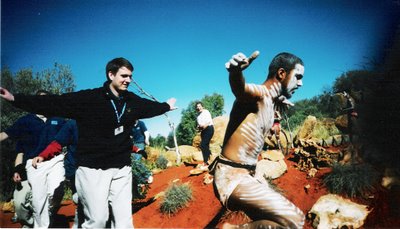In the summer before my junior year in high school, I had the opportunity to travel to Australia for three weeks as a People to People Student Ambassador. I trekked through Sydney, jogged and played basketball through 2000 Olympic Stadium, road camels, flew in a hot air balloon and slept overnight in the famous Outback, snorkled in the Great Barrier Reef, stayed with a host family near Surfer´s Paradise and watched a sunrise at Ayer´s Rock, not to mention all kinds of the little places all in between. One of my fondest memories, Uluru, received a journal entry here that I would like to share.
"One the most moving sights I have enjoyed was made on my visit to Ayer’s Rock. Uluru, as it was named by the Australian indigenous Aboriginese people, is the world famous rock which stands in Australia’s Outback desert. It is featured in every Australian film from Crocodile Dundee to Rescuer’s Down Under. From far away it looks very small, smooth and round but as you walk around its base it is anything but small, standing hundreds of feet high, anything but smooth with ridges dozens of feet high running along its top and sides and more an oval than a circle. Thousands of years of wind have worn the rock with desert-sand like ridges that are even more beautiful than a smooth rock would be. Like a Mt. Everest on an island nation like Australia, it makes perfect sense that Uluru won the reputation and respect of its native people for thousands, maybe hundreds of thousands of years. In ancient tales of the Aboriginese people, the great mountain of rock symbolized the beginning of all life. It was the center of many spiritual stories and a foundation to the cultures of almost every native tribe. As I watched the sun rise on the rock, changing the colors from purple to red to orange to yellow and later as I walked around the entire monolith, I began to understand some of what that must have been like. The Aboriginese people own the rights to the land, allowing them income, autonomy and desired respect in a country that has made leaps forward out of past prejudice toward native people. Today the native worshippers of Uluru still may have their ceremonies atop it, completing their story of life while allowing it to become part of mine. For that I am very grateful still today."
Five years later, I still agree wholeheartedly. I am very lucky to have visited the wonderful country of Australia. Until we meet again, "G´day Aussies!"
"One the most moving sights I have enjoyed was made on my visit to Ayer’s Rock. Uluru, as it was named by the Australian indigenous Aboriginese people, is the world famous rock which stands in Australia’s Outback desert. It is featured in every Australian film from Crocodile Dundee to Rescuer’s Down Under. From far away it looks very small, smooth and round but as you walk around its base it is anything but small, standing hundreds of feet high, anything but smooth with ridges dozens of feet high running along its top and sides and more an oval than a circle. Thousands of years of wind have worn the rock with desert-sand like ridges that are even more beautiful than a smooth rock would be. Like a Mt. Everest on an island nation like Australia, it makes perfect sense that Uluru won the reputation and respect of its native people for thousands, maybe hundreds of thousands of years. In ancient tales of the Aboriginese people, the great mountain of rock symbolized the beginning of all life. It was the center of many spiritual stories and a foundation to the cultures of almost every native tribe. As I watched the sun rise on the rock, changing the colors from purple to red to orange to yellow and later as I walked around the entire monolith, I began to understand some of what that must have been like. The Aboriginese people own the rights to the land, allowing them income, autonomy and desired respect in a country that has made leaps forward out of past prejudice toward native people. Today the native worshippers of Uluru still may have their ceremonies atop it, completing their story of life while allowing it to become part of mine. For that I am very grateful still today."
Five years later, I still agree wholeheartedly. I am very lucky to have visited the wonderful country of Australia. Until we meet again, "G´day Aussies!"



